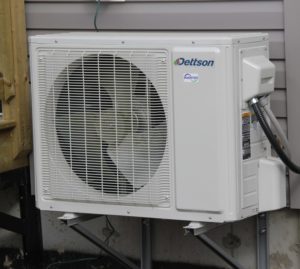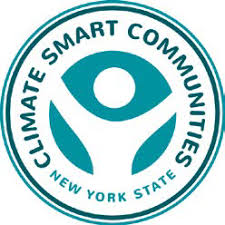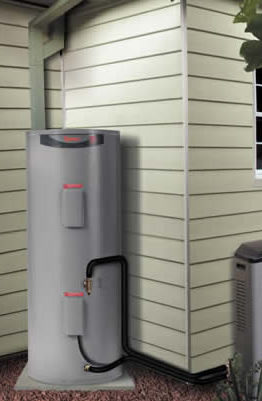Description
This action is to require all new buildings, and buildings undergoing major renovation, to install an all electric heat pump for space heating/cooling and hot water. Heat pumps can be ground source (more efficient) or air source (less expensive). Heat pumps work by moving heat between the interior of a building to either the outside air (air source heat pumps, sometimes called mini splits) or the ground (ground source heat pumps, sometimes called geothermal energy). The heat is moved using the same thermodynamic process that refrigerators and air conditioners use.
Heating, ventilation, and air conditioning (HVAC) accounts for 56% of residential energy end use in New York State and 32% of greenhouse gas emissions. Heat pumps are a replacement for standard HVAC equipment, and can, on average, reduce GHG emissions in New York by 17% with our current energy sources. Once electricity is produced entirely from renewable sources, heat pumps will reduce HVAC GHG emissions in New York by 84% compared to today’s emissions.

1
2
3
Implementation Phases
Require heat pumps in new buildings. Supplemental energy codes can be adopted to require the installation of high efficiency ground source or air source heat pumps in new construction and major renovations.
Require heat pumps when performing renovations on buildings, including town owned buildings. Prioritize replacement of oil and propane fired boilers and water heaters, as well as buildings heated with electric resistive heat.
Develop incentives to encourage heat pump installations in existing buildings, with the intent of achieving full penetration by 2030, when t he Capital Region’s grid electricity is expected to be 67% carbon free.
Challenges
Heat is needed at buildings during extended electrical outages. There are two potential methods to provide heat during these periods:
- Backup power. Natural gas or propane generators are more economical than a battery bank, given the amount of needed energy storage. Another option is onsite solar power with battery storage designed to provide backup power for essential power needs, including auxiliary heating systems, when the power grid is down.
- Dual-fuel heat pumps for buildings that have natural gas supply.
Ground source heat pumps are more efficient, but more costly to install than air source.
Perception remains that air source heat pumps are not effective in northern climates. This is no longer the case. Cold climate air source heat pumps can heat homes when the outside temperature dips below zero degrees Fahrenheit. This underscores the need for public education about heat pump systems to help transform the HVAC market.
Example Municipalities
Several municipalities have already implemented this action…
- As part of Carlsbad California‘s 2015 Climate Action Plan, all construction must “Install solar water heaters or heat pumps on all new residential and commercial construction. Retrofit up to 30 percent of existing homes and commercial buildings to include solar water heaters or heat pumps.”
Greenhouse Gas (GHG) Reductions
Data
Number of residential units in municipality: 14,000 units [Town of Bethlehem Demographic and Growth Analysis 1991-2018, chart 1]
Number of commercial units in municipality: 625 units [ Town of Bethlehem Demographic and Growth Analysis 1991-2018, chart 20]
GHG emissions due to residential natural gas, fuel oil, and propane: 37,800 metric tonnes CO2e. [Bethlehem, NY 2010 Greenhouse Gas Emissions Inventory, Table 1]
GHG emissions due to commercial natural gas, fuel oil, and propane: 13,100 metric tonnes CO2e. [Bethlehem, NY 2010 Greenhouse Gas Emissions Inventory, Table 1]
Emissions reductions from using variable speed electric heat pumps in New York: 18%. [Analysis of Greenhouse Gas Emissions from Residential Heating Technologies in the USA, Fig. 19]
New residential housing units in municipality: 65 units per year [Town of Bethlehem Demographic and Growth Analysis 1991-2018, p. 9]
New commercial units in municipality: 7 units per year [Town of Bethlehem Demographic and Growth Analysis 1991-2018, p. 37]
Assumptions
This analysis assumed that all residential and commercial natural gas, fuel oil, and propane is used for heating.
Phase 1 implementation calls for heat pumps in all new residential and commercial buildings.
Methodology
We calculated:
- The average GHG emissions due to heating per residential and commercial unit.
- The average reductions in emissions per residential and commercial unit by switching to heat pumps.
- The reductions in emissions by requiring that new residential and commercial buildings use electric heat pumps.
Results
50 Metric Ton CO2 e is reduced when all new buildings install an all-electric heat pump for space heating.
This results in MODERATE GHG emissions reductions.

Climate Smart Communities (CSC) & Clean Energy Communities (CEC) Link
No direct counterpart exists for this action in the CSC and CEC frameworks, but these frameworks do provide credit for requiring and installing heat pumps in government buildings. Municipalities can:
CEC Actions:
- Earn 500 CEC points for installing heat pumps in a government building through CEC’s Clean Heating and Cooling Demo.
CSC Actions:
- Access 1-5 CSC points for installing heat pumps in government buildings through CSC’s PE3 Action: HVAC Upgrades, and 9-22 points for similar installations through CSC’s PE4 Action: Heat Pumps.
- Access 2-5 CSC points for setting overall green building standards for government buildings through CSC’s PE3 Action: Green Building Standard for Government Buildings.

Co-benefits
There are multiple co-benefits to completing this action including:
- Lower annual heating/cooling operating costs
- Less maintenance
- Quiet operation
- Combined with solar panels, homes can be self-sufficient
- Provides cooling as well as heating
- Long life
- Safer than traditional HVAC systems
Resources
https://www.nyserda.ny.gov/Residents-and-Homeowners/Heat-and-Cool-Your-Home/Heat-Pumps?utm_source=google&utm_medium=search&gclid=Cj0KCQiA962BBhCzARIs AIpWEL2SyMdei8GmpgkzKTFSPQfkTJdPHBixXyRS1GdZhZ 16sMY7YivLLSgaAtUjEALw_wcB
https://wcec.ucdavis.edu/wp-content/uploads/GHG-Emissions-from-Residential-Heating-Technologies-091520.pdf, Fig. 19. Value is for all-electric, variable-speed heat pumps.
https://wcec.ucdavis.edu/wp-content/uploads/GHG-Emissions-from-Residential-Heating-Technologies-091520.pdf, Fig. 28.
https://www.nationalgridus.com/news/assets/80×50-white-paper-final.pdf
https://heatsmartcapitalregion.com/
https://www.nationalgridus.com/Services-Rebates?r=10&page=1&customerType=For+Homeowners&locations=U pstate+New+York&fuelType=Electric&interestedIn=]
https://www.nationalgridus.com/news/assets/80×50-white-paper-final.pdf
https://www.energy.gov/energysaver/heat-and-cool/heat-pump-systems
https://energysavingtrust.org.uk/air-source-heat-pumps-vs-ground-source-heat-pumps/ https://www.aceee.org/sites/default/files/publications/researchreports/a1803.pdf
https://nyforcleanpower.org/clean-heating-and-cooling/
https://www.sierraclub.org/articles/2020/04/new-analysis-heat-pumps-slow-climate-change-every-corner-country
https://wp.nyu.edu/dispatch/2020/03/12/are-heat-pumps-capable-of-helping-us-stave-off-impacts-of-climate-cha nge/
https://wcec.ucdavis.edu/wp-content/uploads/GHG-Emissions-from-Residential-Heating-Technologies-091520.pdf
https://wcec.ucdavis.edu/wp-content/uploads/GHG-Emissions-from-Residential-Heating-Technologies-091520.pdf
https://cleantechnica.com/2020/12/28/for-co2-reduction-from-existing-buildings-heat-pumps-are-better-than-effic iency/
https://www.veic.org/Media/default/documents/resources/reports/veic-ramping-up-heat-pump-adoption-in-new york-state.pdf
https://www.carlsbadca.gov/services/depts/pw/environment/cap/waterheat.asp
https://wcec.ucdavis.edu/wp-content/uploads/GHG-Emissions-from-Residential-Heating-Technologies-091520.pdf



